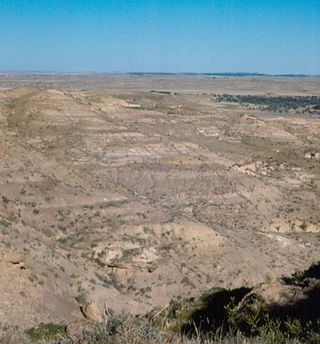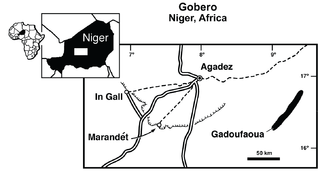
Ceratopsia or Ceratopia is a group of herbivorous, beaked dinosaurs that thrived in what are now North America, Europe, and Asia, during the Cretaceous Period, although ancestral forms lived earlier, in the Jurassic. The earliest known ceratopsian, Yinlong downsi, lived between 161.2 and 155.7 million years ago. The last ceratopsian species, Triceratops prorsus, became extinct during the Cretaceous–Paleogene extinction event, 66 million years ago.

Quaesitosaurus is a genus of nemegtosaurid sauropod containing only the type species, Q. orientalis, described in 1983. It lived from 72 to 71 million years ago during the Late Cretaceous epoch in the Barun Goyot Formation. With long, low and horse-like with frontally located peg-teeth, the skull of Quaesitosaurus is similar enough to the skull of Diplodocus and its kin to have prompted informed speculation that the missing body was built like those of diplodocids.

Antarctosaurus is a genus of titanosaurian sauropod dinosaur from the Late Cretaceous Period of what is now South America. The type species, Antarctosaurus wichmannianus, and a second species, Antarctosaurus giganteus, were described by prolific German paleontologist Friedrich von Huene in 1929. Three additional species of Antarctosaurus have been named since then but later studies have considered them dubious or unlikely to pertain to the genus.

The Lance (Creek) Formation is a division of Late Cretaceous rocks in the western United States. Named after Lance Creek, Wyoming, the microvertebrate fossils and dinosaurs represent important components of the latest Mesozoic vertebrate faunas. The Lance Formation is Late Maastrichtian in age, and shares much fauna with the Hell Creek Formation of Montana and North Dakota, the Frenchman Formation of southwest Saskatchewan, and the lower part of the Scollard Formation of Alberta.
Jeffrey A. Wilson, also known as JAW, is a paleontologist and professor of geological sciences and assistant curator at the Museum of Paleontology at the University of Michigan.

Yaverlandia is a genus of maniraptoran dinosaur. Known from a partial fossil skull found in Lower Cretaceous strata of the Wessex Formation on the Isle of Wight. it was described as the earliest known member of the pachycephalosaurid family, but research by Darren Naish shows it to have actually been a theropod, seemingly a maniraptoran. The type species is Y. bitholus.

Denversaurus is a genus of panoplosaurin nodosaurid dinosaur from the late Maastrichtian of Late Cretaceous Western North America. Although at one point treated as a junior synonym of Edmontonia by some taxonomists, current research indicates that it is its own distinct nodosaurid genus.
The Oldman Formation is a stratigraphic unit of Late Cretaceous age that underlies much of southern Alberta, Canada. It consists primarily of sandstones that were deposited in fluvial channel and floodplain environments. It was named for exposures along the Oldman River between its confluence with the St. Mary River and the city of Lethbridge, and it is known primarily for its dinosaur remains and other fossils.

Isisaurus is a genus of titanosaurian dinosaur from the Late Cretaceous Lameta Formation of India and Pab Formation of Pakistan. The genus contains a single species, Isisaurus colberti.

Saltasauridae is a family of armored herbivorous sauropods from the Upper Cretaceous. They are known from fossils found in South America, Africa, Asia, North America, and Europe. They are characterized by their vertebrae and feet, which are similar to those of Saltasaurus, the first of the group to be discovered and the source of the name. The last and largest of the group and only one found in North America, Alamosaurus, was thirty-four metres in length and one of the last sauropods to go extinct.

The Lameta Formation, also known as the Infratrappean Beds, is a sedimentary geological formation found in Madhya Pradesh, Gujarat, Maharashtra, Telangana, and Andhra Pradesh, India, associated with the Deccan Traps. It is of the Maastrichtian age, and is notable for its dinosaur fossils
The Paw Paw Formation is a geological formation in Texas whose strata date back to the late Albian stage of the Early Cretaceous. Dinosaur remains are among the fossils that have been recovered from the formation.
The Tiourarén Formation is a geological formation in the Agadez Region of Niger whose strata were originally thought to be Early Cretaceous. However, re-interpretation of the sediments showed that they are probably Middle or Late Jurassic (Bathonian-Oxfordian) in age. Other works suggested it reaches the Barremian. It is the uppermost unit of the Irhazer Group. Dinosaur remains & other vertebrates are among the fossils that have been recovered from the formation. Originally part of the "Argiles de l'Ihrazer", the Tiouaren Formation primarily comprises reddish to purple siltstones with occasional marls, limestones, and scarce channel sandstones.
The Fort Crittenden Formation is a geological formation in Arizona whose strata date back to the Late Cretaceous. Dinosaur remains are among the fossils that have been recovered from the formation.

The Aguja Formation is a geological formation in North America, exposed in Texas, United States and Chihuahua and Coahuila in Mexico, whose strata date back to the Late Cretaceous. Dinosaur remains are among the fossils that have been recovered from the formation. Fossil palms have also been unearthed here.
The Densuș-Ciula Formation is a geological formation in Romania whose strata date back to the Late Cretaceous. It forms part of the Hațeg Island assemblage. Dinosaur remains are among the fossils that have been recovered from the formation. It is divided up into three members, the lower member is noted for high content of volcanogenic material and is poorly fossiliferous. While the Middle member consists of silty mudstones, sandstones and conglomerates containing volcanogenic clasts and is richly fossiliferous, while the upper member consists of matrix supported red conglomerates and is poorly fossiliferous.
Pabwehshi is an extinct genus of mesoeucrocodylian. It is based on GSP-UM 2000, a partial snout and corresponding lower jaw elements, with another snout assigned to it. These specimens were found in Maastrichtian-age Upper Cretaceous rocks of the Vitakri and Pab Formations in Balochistan, Pakistan, and represent the first diagnostic crocodyliform fossils from Cretaceous rocks of South Asia. Pabwehshi had serrated interlocking teeth in its snout that formed a "zig-zag" cutting edge. Pabwehshi was named in 2001 by Jeffrey A. Wilson and colleagues. The type species is P. pakistanensis, in reference to the nation where it was found. It was traditionally classified as a baurusuchid closely related to Cynodontosuchus and Baurusuchus. Larsson and Sues (2007) found close affinity between Pabwehshi and the Peirosauridae within Sebecia. Montefeltro et al.Pabwehshi has a sagittal torus on its maxillary palatal shelves – a character that is absent in baurusuchids – but they did not include Pabwehshi in their phylogenetic analysis.

The Elrhaz Formation is a geological formation in Niger, West Africa.
Induszalim is an extinct genus of mesoeucrocodylian reptile from the Pab Formation of Balochistan, Pakistan. The type, and only species, I. bala, was named and described in 2006.










